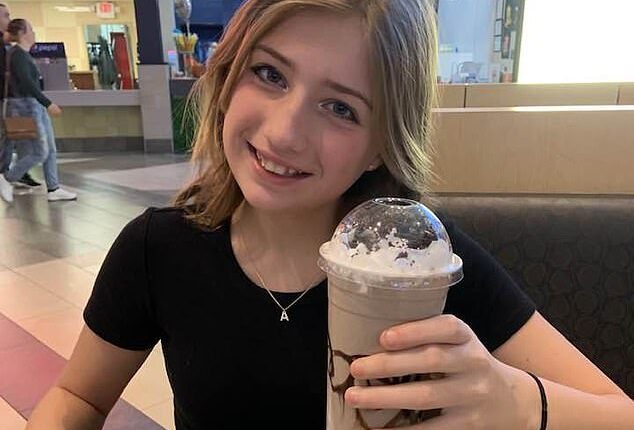Audree Heine was always trying on new versions of herself.
Like most children on the cusp of teen-hood, suspended between innocence and the urge for independence, she changed through identities like seasons, hoping one would eventually stick.
Sometimes she’d sing Taylor Swift songs in a pink cowboy hat and matching boots. Other times, she’d strum a Nirvana song on her guitar, chipped nail polish on her fingers – the picture of teenage angst.
At school, she might clip a furry tail to her jeans and joke about being part animal. Other days, she’d question whether she was straight, bisexual, or just not sure yet.
Her mother, Jaimee Seitz, never minded. She encouraged her daughter’s self-expression. ‘I let her be whoever she wanted,’ she told the Daily Mail. ‘If she wanted to be a cowgirl one day, a furry the next, that was fine. She was just finding herself.’
But Audree never quite found her place. At her middle school in northern Kentucky, the cliques were well-defined – the cheerleaders, the athletes, the gamers – and Audree didn’t fit into any of them.
She was seeking connection, not conformity. After struggling to find it at school, Audree turned to social media in search of somewhere to belong.
It was in a dark corner of TikTok that she finally found it, among a group of fellow teens and self-described outsiders who call themselves the True Crime Community, or TCC for short.

Audree Heine was bright and creative. She was constantly reinventing herself, her style, and her interests
At first, the TCC appeared harmless enough: true crime videos and slick edits of shows like Heathers and 13 Reasons Why.
But somewhere in the endless scroll, the tone darkened. Her feed was no longer filled with dashcam footage and documentary clips, but posts glorifying school shooters, celebrating violence, and encouraging self-harm.
Jaimee was unaware of the dangerous rabbit hole her daughter had fallen down, and the truth would be realized too late.
On December 2, 2024 – exactly one week after her 13th birthday – Jaimee found Audree hanging in her bedroom.
The night before had been completely ordinary.
Audree was practicing her guitar in her room. She showed her mom a video of an ostrich she found hysterical and laid out her outfit for school the next day.
She then went to her room, phone in hand, telling her mom she loved her. Jaimee heard the shower run, then shut off. Through the wall, she could hear the faint hum of Audree’s TV before the house fell silent.
When Jaimee woke a few hours later, her world changed forever. At first, she thought there had been some mistake – that her daughter’s death might have been the tragic result of an attempt to replicate some bizarre online challenge.
It was only after police began combing through Audree’s phone and personal effects that they uncovered a window into the secret, disturbing world she’d been inhabiting for months.

Jaimee Seitz tragically discovered her daughter dead on December 2, 2024

Audree had just turned 13 a week earlier. Jaimee couldn’t make sense of what had happened
Audree’s death had been no accident.
Her internet history was filled with videos about the Columbine massacre and Sandy Hook – clips that fawned over the killers, cast them as victims – as well as disturbing memes about depression and suicide.
‘I remember sitting with the detective,’ Jaimee recalled. ‘He said, “Have you heard of something called TCC?” and I said, “What the hell is that?”
‘Then he explained how there’s this whole group of kids who worship school shooters. My mind was blown. I thought, no, not my daughter. There’s no way.’
Then the detective slid a spiral-bound notebook across the table. It had been found in Audree’s school locker.
On the front, scrawled in marker, were the words ‘Audree Klebold’ – a chilling reference to one of the Columbine killers, Dylan Klebold.
‘I’d never seen it before,’ Jaimee said. ‘Inside were drawings, rants, suicide notes, countdowns. One page said, “39 days until I’m gone.” It broke me. I didn’t even know this version of my daughter existed.’
The entries swung violently between hope and despair – plans for camping trips written beside passages about death. In one line, she wrote: ‘I’m just ready to die. I’ll be happier wherever I go.’
Audree’s writing also veered between fact and fiction, sometimes within the same sentence.

A search of Audree’s interest history revealed a disturbing truth: She’d spent the last three months interacting with an online group known as the True Crime Community (TCC)

In her school locker, police also found a notebook with passages fawning over school shooters and counting down to her ‘death day’

An excerpt from her diary is seen above, showing a cartoon drawing of Dylan Klebold with love hearts and stars around him

The TCC worships Eric Harris and Dylan Klebold, who went on a rampage at Columbine High School in 1999, killing 13 and injuring 24
In one entry, she claimed she’d ‘blown up [her] mom’s microwave trying to make a homemade bomb’ – something Jaimee insists never happened.
In others, she described conversations with ‘Eric’ and ‘Dylan,’ which Jaimee believes were either online friends or imagined exchanges with real-life school shooters like Columbiners Eric Harris and Dylan Klebold.
Her writings revealed a clear fixation on her own death, too. She repeatedly mentioned wanting to die and even began counting down the days until she planned to end her life, marking each entry like a milestone leading to what she called her ‘death day.’
Jaimee recognized the handwriting as her daughter’s, but the thoughts articulated appeared to be the work of a total stranger.
‘So much of what she wrote went back and forth between what was real and what wasn’t,’ said Jaimee. ‘I think she started to believe some of the things she was writing, and the line between fact and fiction blurred.
‘At home, she was just my silly, goofy kid who loved animals and wanted to be a vet. I had no idea what was happening behind that screen.’
In the months since Audree’s death, Jaimee has replayed every moment, searching for signs she might have missed, while painstakingly researching the TCC and reporting every video she finds.
What she’s learned is that her daughter wasn’t alone – that countless other teenagers are being drawn into the same dark online echo chambers – and she’s made it her life’s mission to warn other parents before it’s too late.
Sounding the alarm, too, is the Anti-Defamation League, which has called the TCC one of the internet’s most insidious breeding grounds for violent ideation.

Jaimee struggled to reconcile the sweet, caring daughter she knew with the tortured and disturbed soul she professed to be in her secret writings

Posts within the TCC worship Klebold and Harris, based off a misconception that spread about Columbine in the immediate aftermath of the shooting

The deranged philosophy is known as the ‘Columbine Effect’
In recent months, the ADL has linked the TCC to three school shootings across the US in the last year, each carried out by teenagers who, like Audree, idolized the Columbine gunmen.
‘There’s a through-line between these shootings that is incredibly concerning,’ an ADL expert told the Daily Mail last month.
‘These shooters seem to be feeding off one another and influencing one another – emulating their predecessors, egged on by the promise of glorification in these spaces.’
This twisted fixation on Harris and Klebold is not new.
Columbine remains at the heart of TCC due to the mythology that sprang up in the aftermath of the 1999 attack. Early news reports falsely cast Harris and Klebold as bullied loners who snapped and sought revenge on their tormentors.
As author Dave Cullen wrote in The Atlantic in 2024, the truth – that Harris was a sadistic psychopath and Klebold suicidally depressed – was far more complex. But the simpler legend of two outcasts striking back at their bullies stuck, and it has endured.
That myth turned Harris and Klebold into folk heroes for alienated teens. Cullen refers to the twisted phenomenon as the ‘Columbine Effect.’
For Jaimee, now that she’s aware of TCC, she can spot some of the warning signs she missed.
‘There are so many, it’s insane,’ she said. ‘T-shirts, bracelets – anything referencing Columbine. If they’re making or wearing stuff like that, you need to pay attention.’

Jaimee said she made the difficult decision to speak out about her daughter’s death to educate other parents before its too late

If she helps to save just one live, Jaimee said the senselessness of her daughter’s death will find meaning
Audree, Jaimee now realizes, had begun adopting some of those visual cues.
She’d wear band shirts favored by the Columbine killers and ask her mom to make her customized shirts with strange slogans – shirts she’d later learn had been worn by other mass shooters.
But while many within the TCC fantasize about harming others, Jaimee says Audree’s fixation was turned inward.
She believes her daughter wasn’t moved by the ideology of the killers worshipped by her digital peers, but rather drawn to the mythology of martyrdom they represented.
‘When you join this group, you’re either going to kill yourself or kill others,’ said Jaimee. ‘Audree would never hurt a fly, but she was still radicalized, just in a different way.
‘She thought she was broken, that she didn’t belong, and those people online made her believe the only way to be part of it was to die too.’
While Audree never plotted violence, authorities discovered she had been in communication with two teenagers who’d been planning to bomb their school in Indiana.
The plot was foiled before any harm could be done, and the pair are now receiving help.
The frightening discovery has only deepened Jaimee’s conviction that her daughter’s tragic story must serve as a cautionary tale.
What happened to Audree, she says, is proof of how quickly a curious teenager can be swallowed by a vacuum of hate and destruction.
‘I don’t want her death to be in vain,’ Jaimee said. ‘If talking about it saves even one kid, then at least there’s a purpose, because I can’t bring mine back.
‘All I want is for her life, and even her death, to mean something.’







